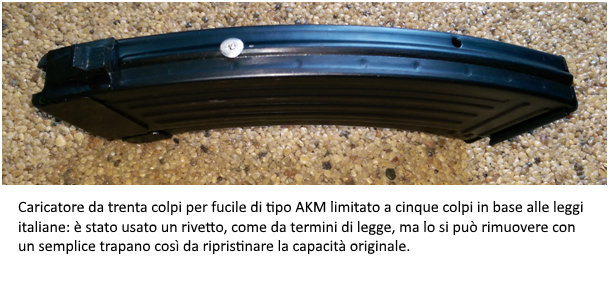We have been asked why we don’t want a ban on high capicity magazines.
We summed up the opinions of two professors and of our own experts :
- Ban could limit only a few of already very rare events
- Ban is unjust and unenforceable
- 27 arguments by FIREARMS UNITED experts
Watch this video!
We answered in March with the words of Prof. Dr. Gary Kleck:
Ban could limit only a few of already very rare events
“The only kind of shootings in which large numbers of rounds are commonly fired are mass shootings, incidents that involve many victims. Mass shootings fortunately are quite rare in absolute terms….
Even in the extremely rare mass shootings in which large numbers of victims were shot, the shooters virtually never needed “large capicity magazines” to injure or kill as many victims as they did, because they either
(a) possessed multiple guns,
(b) possessed multiple magazines, or
(c) had ample time and opportunity to reload, using smaller-capacity magazines.Therefore, even the hypothetical potential for reducing harm or improving the public’s safety by limiting magazine capacity […] can be fairly described as being limited to no more than a very small subset of already very rare events.”
Ban is unjust and unenforceable
Even the slight benefit promised by a ban on large magazines — forcing mass shooters to delay momentarily — is outweighed by the unfortunate consequences of passing a law that normally law-abiding people won’t #obey.
If past experience is any guide, the magazine ban is just such a law. In 2013 Sunnyvale banned high-capacity magazines and, after a grace period for gun owners, police reported that not a single person had turned in a magazine. Los Angeles and San Francisco enacted similar laws and few, if any, gun owners have disposed of their magazines.
Legal theorists argue that people are more likely to comply with laws they view as morally or socially just. To a person whose gun came standard with one of these magazines and who has owned it for years without incident, the idea that these devices are inherently dangerous does not resonate.
In the absence of cooperation from gun owners, the large-magazine ban is unenforceable. It would be practically and politically impossible for the government to go door to door to find and collect the magazines. The ban will be enforced only when someone gets caught with one, say in a search related to an arrest.
Opinion by Adam Winkler, professor at UCLA School of Law, at Los Angeles Times in 2016
FIREARMS UNITED expert’s opinion
- Forcing people to become member of a club in order to obtain an exemption is against the ECHR (Ruling of the Dutch Supreme Court) and often against the constitution (Finland). This would in fact make it impossible to apply this exemption.
- Making exemption dependent on the rules of certain sport shooting disciplines creates legal uncertainty because a private organisation can change the rules, suddenly making a group of weapons illegal, turning owners of these weapons into criminals without knowing it.
- A differentiation in limitation between short guns and long guns creates mass confusion as there are many magazines that can be used in both types of weapon.
- Magazines are not essential components so are not controlled by the directive, so how can you place them in cat A?
- The situation of ‘magazine in weapon: cat A, magazine out of weapon: cat B’ does not make sense and is unenforceable.
- What has to be done with all those hicap magazines lying around? Estimated number is more than 20 million. In the beginning nobody will have 20rd mags so 30rd mags will be converted. How is that to be done? Will there be rules on how to convert? Does the conversion have to be permanent? The rules for conversion of magazines that are used in Italy are ineffective. Remember the story about the IPSC rifle shooter who carries a drill and a riveting device in his bag in order to conform to the different standards at home and abroad?
- Magazines are not single objects but consist of three, four or even more parts. Which part decides whether the mag is cat A? Which parts will be illegal?
- There is no definition of the term ‘loading device’.
- Talk is of loading devices. Belts? Hoppers? If a person has 21 links for machinegun belts, will his license be taken away?
- Will his license be taken away if he possesses a 30 round magazine that does not fit in any of the guns on his license?
- If a person has an exempted Cat A carbine with which he shoots IPSC competition, how is he going to take it to a match in another country? It is not possible to put a cat A firearm on an European Firearms Pass, exemption or not. If the EFP is expanded to cat A this totally defeats the purpose of that category as apparently the idea that civilians should not have any cat A weapons, let alone travel with them, is defeated.
- How are loading devices going to be registered if they are not marked? How is the firearms’ register going to deal with transfer of exempted loading devices between sport shooters, dealers and collectors? How does such a transfer (under exemption status) have to take place legally? What documents will be required?How will a dealer assure that the exemption applies to the shooter he sells the magazine to?
- There will be an exemption for sport shooters who are member of a club. What about dealers that are not member of a club but sell to sport shooters? Will they need an authorization under article 6.1? How about collectors of magazines or of firearms?
- Cat A is reserved for weapons that should absolutely not be in the hands of civilians. Issuing cat A authorisations to sport shooters totally defeats that purpose and opens up the discussion about possession of forbidden weapons. It nullifies the principles behind cat A.
- Collectors of semiautomatic pistols will have a problem because early semiautomatic pistols were sometimes issued with hi –capacity magazines (eg the Luger with the 30rd ‘snail drum magazine’). Collectors of these cat B weapons will now have to request a cat A authorization, for which the security measures are out of proportion to the threat these magazines pose.
- In MS where collectors are not granted cat A authorisations the collectors will have to block these magazines (value up to 1000 Euro per piece) at 20 rounds, using welding or a rivet. That destroys their value so an exemption for collectors will be needed.
- If grandfather guns are exempted, sport shooting guns are exempted, collectors’ guns are exempted and .22 rimfire guns are exempted, what exactly are we banning? 5% of the total? This makes the ban nothing more than a symbolic gesture, and a small one at that. Is that worth the effort? It will cost a lot of law enforcement resources that might be spent more effectively.
- The wording (as written by the EU council) is so unclear that it could be (and will be) read as a total ban on semiautomatics with detachable magazines.
- Magazines can easily be modified or produced (even on 3D printers)
- What would be the status of expandable magazines like the ones from Thermold? Normally they hold 20 but they can be expanded to hold 30.
- What would be the status of coupled magazines (several 20rd magazines clipped or taped together, side by side or bottom to bottom)?
- All firearms concerned are already on license in all Member States. They are therefore fully controlled. The failure to enforce any rules should not be blamed on the object.
- Production of magazines has tolerances. What happens if a magazine designed to hold 20 rounds deforms a bit under pressure or is worn and then, with some effort, can hold 21 rounds?
- There are many millions large capacity magazines out there. The owners of these will have to be compensated. None of those magazines have been registered (not being essential components) so how much manpower will be needed to find, destroy and prosecute?
- What is to be gained from this measure when it has been established that the difference in time needed for shooting 30 times with a 30 rd magazine or with 3 10 round magazines is not more than 2 seconds?
- The Netherlands and Norway decided not to put such a measure in place after the shootings in their countries. What has changed so that such a measure is now planned on European level?
- No magazine capacity ban anywhere in the world has shown any statistically proven positive effect. Most have been quietly repealed.
As for the ban on folding stocks:
- The stock is not considered an essential component of a firearm. That means they can be possessed without paperwork. Thus the owner of a semiautomatic can possess the firearm and the folding stock as long as he does not put them together. That defeats the whole purpose of the measure.
- There is mention of a license being withdrawn if a person legally possesses a semiautomatic but also has an oversize magazine. Will there be a similar situation for persons owning a semiautomatic firearm and, separately, a folding stock?
- There are many shoulder firearms that have adjustable stocks (to adjust to the shoulder breadth of the shooter). Where does the adjustable stock end and the telescopic stock begin? It is a discussion that raged for years in the Netherlands, even ending up in court.
- What is the status of short firearms to which a shoulder stock is attached? Like with a Mauser C96 pistol or a Glock, that can both be fitted with a shoulder stock, often called a PDW (Personal Defense Weapon)
- How many of the firearms with folding stock that were used in the recent terrorist attacks were shorter than 60cm and was any of those acquired in the legal market?
- What is the definition of “without using tools”? Is a bullet point or coin considered a tool?
- What is the definition of the term “without losing functionality”?
- Many semiauto long firearms, like the Ruger Mini 14, can be disassembled without using tools, including taking off the stock. The weapon can be fired (maintaining ‘functionality’) but is difficult to hold. What is the status of such a weapon?


 English
English Deutsch
Deutsch Italiano
Italiano Français
Français Español
Español suomi
suomi Polski
Polski Eesti
Eesti Português
Português Svenska
Svenska Română
Română
One Comment on “Arguments against a ban of “High Capicity” magazines”
IM VERY WORRIED !!!!!!!!!
AFTER TODAY 3-6-2017 EVENTS IN LONDON THAT I SEE THE TERRORIST USE A WHITE VAN
MAYBE EUROPEAN COMMITION WILL NOW STOP THE USE OF THE ALL THE WHITE VANS NOW